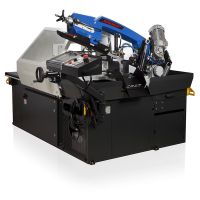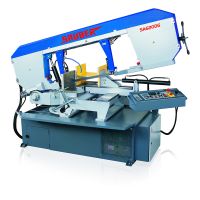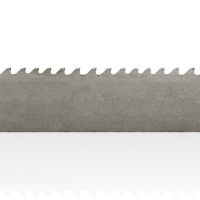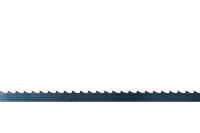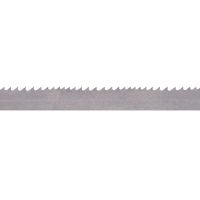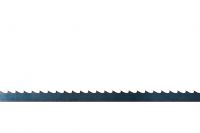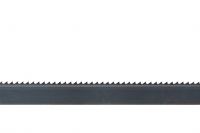Why are my bandsaw blades going blunt?
There are a range of reasons a bimetal bandsaw blade may go blunt prematurely. In order of commonality, the following are the main factors we see when we’re out and about:
- Blade speed
- Coolant concentration
- Number of teeth in the cut
- Downfeed rate
- Tooth geometry vs. material type
- Foreign material interference
Blade speed can have a dramatic effect on how soon your blade goes blunt, especially when cutting materials which are prone to work hardening such as stainless. Know your material, and know the recommended rotation speed for that material. Some common material speeds are as follows:
Mild – medium tensile steel: 70-100 metres/min
High tensile/tough steel: 45-60 metres/min
Stainless steel: 20-35 metres/min
In the starkest illustration of the effect band speed can have on blade life, one customer went from killing blades in 10 cuts on stainless billet (about 1 hour’s work) to getting 9 months’ work out of one blade – by changing nothing but the band speed.
Have different/difficult material? Ask us, we can give you an exact recommendation.
Coolant concentration pretty much ties with blade speed as a top factor in blade tooth wear, but the effect is less dramatic. Sometimes we ask users how much coolant is being used, with a reply of ‘heaps, its flooding all over the blade’ – however that isn’t quite the answer we’re looking for. The job of the coolant is to keep the blade cool by lubricating it, not to cool it down by drowning it!
So, what is important, is the concentration of soluble oil in the mix. Where you have a tool with multiple cutting points in contact with the workpiece at one time, you also have a multiplication of friction points which needs to be remedied by more lubrication. For mild & medium tensile steels this typically means 15% of your mix needs to be oil concentrate, and for stainless and other difficult materials it should be 20%. This is in contrast to what most manufacturers recommend, but nonetheless pays off in reduced blade costs.
Beware of topping up your tank with water only! Over time it will dilute the mix, and you’ll find yourself going through blades again. A good quick test is to rub a little of the mixed up coolant between your fingers. It should feel more than slippery, close to soapy indicates sufficient lubricating power in your mix.
Number of teeth in the cut. As touched on above, multiple cutting points in contact with the workpiece adds up to a multiplication of friction points, and thus heat generation. Excess heat generation softens and blunts cutting points, so one way to lower this risk is to lower the number of tooth points in contact with the workpiece. Obviously, don’t go too low or you’ll risk ripping teeth off instead!
Downfeed rate. Cut too fast, you risk chipping and stripping teeth. Cut too slow, and the teeth on a blade may be doing little more than rubbing the surface of the cut. Rubbing can lead to the workpiece hardening and becoming impenetrable to the teeth, which then obviously go blunt. Even when running a blade in, it is still critical it is feeding in at a rate which will steadily penetrate the material. Fine sandy chips are OK for running in a blade, but after that increase the feed until you have curled chips.
Tooth geometry vs. material type. Different size and types of materials require different tooth geometries to perform at an optimum level. Most standard bimetal blades have a neutral, that is zero-degree face rake on variable tooth pitches of 5-8 and finer. This is so they don’t dig into and grab on the thinner sections they are designed to cut. However, the same feature of not digging into the material quickly becomes a disadvantage on large or solid sections where you need teeth with extra bite to penetrate the material at an adequate rate. If they don’t, the same situation of little more than rubbing the surface of the cut can occur, with the results the same as outlined in the section ‘Downfeed rate’ above. The solution for larger sections is to go for a blade which has a positive rake tooth which is designed to penetrate larger sections.
Extra tough or hard materials sometimes require a different type of bimetal blade, or even carbide tipped blades in order to cut at a rate which won’t harden the workpiece. Duplex, titanium, chrome and induction hardened bar are examples of such materials. Bimetal blades for these applications typically have a very positive tooth hook angle as well as specially ground tooth geometry, and sometimes a higher cobalt content tooth material.
Foreign material interference. In the same way as hidden – or not so hidden nasties can rip teeth off a blade, they can also cause it to simply go blunt double quick. The more common ones are:
- Hard spots in the material. There is very little you can do about this, other than call it rotten luck and maybe poor quality material.
- The machine is set to allow the blade to cut into the bed of the machine. If the bed is quite a hard material (as it often is) you can expect you blade to go blunt quicker.
- Machine parts such as guards and slow-approach arms which are loose and can interfere with the blade.
- Foreign objects on or in the material such as weld spatter, gravel from off the yard etc.
If you have a specific blade problem you are unable to get to the bottom of, please reach out to one of our team – we get a buzz out of solving them!


